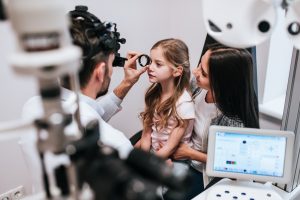 Summer is almost over and it’s back to school season!
Summer is almost over and it’s back to school season!
As parents, many of us are busy ensuring our kids are ready and prepared for the new school year; worrying about school supplies, new clothes, and new haircuts. There is always a long list of things to do before school starts. But something that often gets overlooked is getting your child’s eyes examined annually.
Early eye examinations are crucial to make sure children have normal, healthy vision so they can perform better at schoolwork and play. Early identification of a child’s vision problem can be crucial because children often are more responsive to treatment when problems are diagnosed early. Early eye exams also are important because children need the following basic skills related to good eyesight for learning:
- Near vision
- Distance vision
- Binocular (two eyes) coordination
- Eye movement skills
- Focusing skills
- Peripheral awareness
- Hand-eye coordination
Parents also need to be alert for the presence of vision problems such as ‘crossed’ eyes or ‘lazy’ eye. These conditions can develop at a young age. ‘Crossed’ eyes or strabismus involves one or both eyes turning inward (towards the nose) or outward. Amblyopia, known as ‘lazy’ eye, is a lack of clear vision in one eye, which can’t be fully corrected with eyeglasses. Lazy eye often develops as a result of ‘crossed’ eyes, but may occur without noticeable signs. ‘Lazy’ eye can be treated if caught early.
In addition, parents should watch their child for indication of any delays in development, which may signal the presence of a vision problem. Difficulty with recognition of colors, shapes, letters and numbers can occur if there is a vision problem. Children generally will not voice complaints about their eyes, therefore parents should watch for signs that may indicate a vision problem, including:
- Sitting close to the TV or holding a book too close
- Squinting
- Tilting their head
- Constant eye rubbing
- Extreme light sensitivity
- Poor focusing
- Poor visual tracking (following an object)
- Abnormal alignment or movement of the eyes (after 6 months of age)
- Chronic redness of the eyes
- Chronic tearing of the eyes
- A white pupil instead of black
Scheduling Eye Exams for Your Child
If eye problems are suspected during routine physical examinations, a referral should be made to an eye doctor for further evaluation. Eye doctors have specific equipment and training to assist them with spotting potential vision problems in children.
When scheduling an eye exam for your child, choose a time when he or she usually is alert and happy.
Glasses and Contacts – Keep these tips in mind for kids who wear glasses:
- Plastic frames are best for children younger than 2.
- Let kids pick their own frames.
- If older kids wear metal frames, make sure they have spring hinges, which are more durable.
- An elastic strap attached to the glasses will help keep them in place for active youngsters.
- Kids with severe eye problems may need special lenses called high-index lenses, which are thinner and lighter than plastic lenses.
- Polycarbonate lenses are best for all kids, especially those who play sports. Polycarbonate is a tough, shatterproof, clear thermoplastic used to make thin, light lenses. However, although they’re very impact-resistant, these lenses scratch more easily than plastic lenses.
- Your eye doctor can help you decide what type of vision correction is best for your child.
Specialists state that 80% of what your youngster learns in school is taught visually. Untreated vision troubles can put children at a substantial disadvantage. Be certain to arrange that your child has a complete eye exam before school starts.


 Make sure they take frequent screen breaks. Instead of focusing directly on the screen, encourage your child to look around the room every now and then, or take some time to stare out the window (at least 20 seconds is recommended by the American Optometric Association). You can even remind them to blink.
Make sure they take frequent screen breaks. Instead of focusing directly on the screen, encourage your child to look around the room every now and then, or take some time to stare out the window (at least 20 seconds is recommended by the American Optometric Association). You can even remind them to blink. It’s easy for us to forget about our eyes let alone our child’s, but it is very important to get your child’s eyes checked regularly.
It’s easy for us to forget about our eyes let alone our child’s, but it is very important to get your child’s eyes checked regularly.